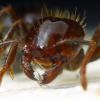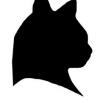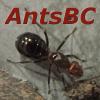1. Location (on a map) of collection: Charleston, SC
2. Date of collection: June 9, 2018 9:00PM
3. Habitat of collection: queen collected under bright outdoor light in urban area
4. Length (from head to gaster): queen 6 1/2 mm
5. Color, hue, pattern and texture: light brown head and thorax, dark gaster with light brown stripes
6. Distinguishing characteristics:
7. Distinguishing behavior: young larvae develope in "flowerlet" clusters (see photo)
8. Nest description: the images are from a test tube setup
9. Nuptial flight time and date: June 9, 2018 9:00PM
Is this lasius americanus? The ants are in a test tube and the colony is about 2 1/2 months old. The pupa are naked and none are in cocoons. The egg to larvae stage seems to develope as "flowerlet" custers... they look like miniature bunches of bananas.























